Winter 2018 Newsletter
Letter From STEMAP TEAM
Dear STEM Ambassadors and Community Partners,
Happy 2018! The year is off to a great start for the STEM Ambassador Program with Ambassadors working on engagement events across the valley. David Belnap visited the Girls Transition Center, Lauren Williams spoke at the 10th East Senior Center, and Dara Niketic collaborated with a tattoo artist from Ironclad Electric Tattoo to discuss art and science.
We are now accepting applications for the 2018 STEMAP Cohort! We are excited for another year full of research and engagement! Space in the cohort is limited, and the application is available until February 14th at 5 PM. Join us on February 12th for an interest meeting where we will have more information about what you can expect this year as an Ambassador.
Program Director Nalini Nadkarni attended a workshop in New York City to explore science engagement efforts across the country, as part of STEMAP’s work to collaborate with other engagement programs and organizations. We hope these efforts will further the national dialogue around science and public engagement.
As part of that effort, the STEMAP is working to gather feedback from scientists regarding the importance of public engagement. You can read more about that project below and share your experiences on our survey.
Finally, we are thrilled to share the STEMAP impact report and video highlighting Ambassador and community partner achievements over the last two years.
We sincerely thank the scientists and community members who have made STEMAP such a success!
Thank you,
Nalini Nadkarni, Director
Caitlin Weber, Program Manager
Megan Young, Program Coordinator
Allyson Jelitto, STEMAP Assistant
2018 STEMAP Application is Live!
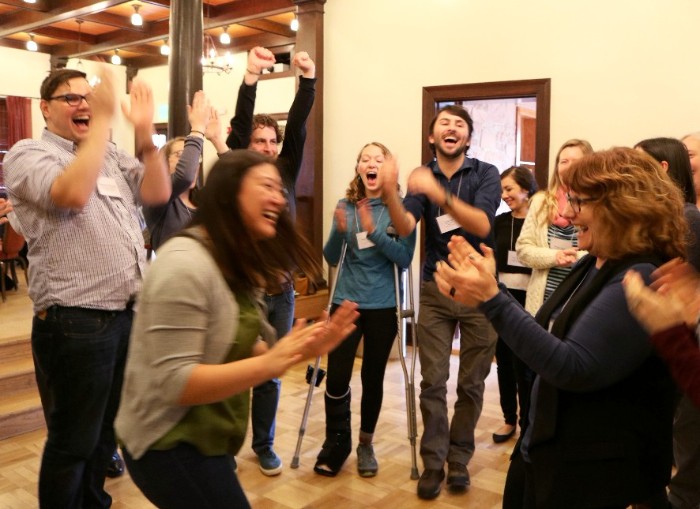
Ambassadors cheer each other on during a training exercise.
The application for the 2018 STEMAP Cohort is now available! STEMAP will be accepting applications until February 14th at 5 PM. Please share the flyer with anyone you know who is interested in the program. Join us February 13th for an informational meeting. Space is limited!
Support Systems for Scientists’ Communication and Engagement
An exploration of the people and institutions empowering effective impact
by Nalini Nadkarni
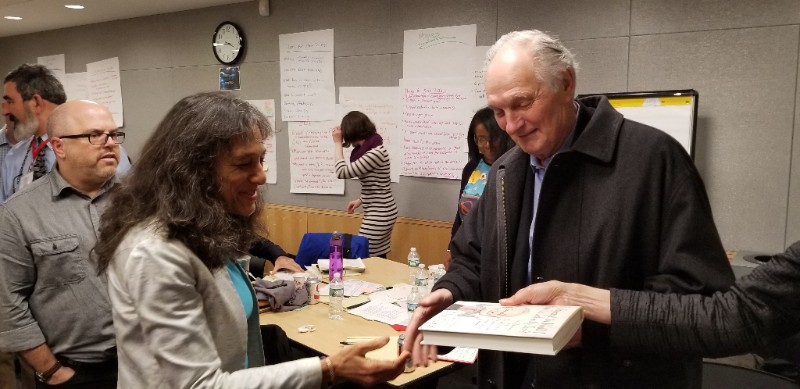
The public needs and wants to connect with science, and scientists need and want to connect with the public. However, the current demand from scientists to do this exceeds the capacity of those who facilitate quality communication and engagement efforts. A visionary group headed by Brooke Smith and supported by four foundations, is identifying the support needed to help scientists connect with the public. Their systems-view vision is that every scientist who wants to engage should be supported to do so.
They have organized five workshops to look critically and creatively at the systems that support scientists’ engagement. Conducted over late 2017 and early 2018, the first four workshops will bring together leaders in different parts of the field who bridge scientists and the public. The fifth workshop will be a plenary event that provides a more holistic view of scientists’ support system to discern directions to advance the field.
These meetings will result in: 1) deepening our understanding of how scientists are currently supported in these areas, 2) mapping the broader support system to expose the opportunities and obstacles that play a role in achieving this goal, and 3) identifying strategic and practical steps that move us closer to this goal.
Dr. Nalini Nadkarni (University of Utah), Director of the STEM Ambassador Program, was invited to attend the first workshop, which took place in New York City in December, 2017. Representatives from 20 science communication training programs discussed their needs. Of these, the STEM Ambassador Program was unique in its emphasis on ‘science-unengaged’ public audiences, and its capacity to help scientists implement and evaluate their efforts. Stay tuned for further events for these exciting efforts!
STEMAP Impact Report
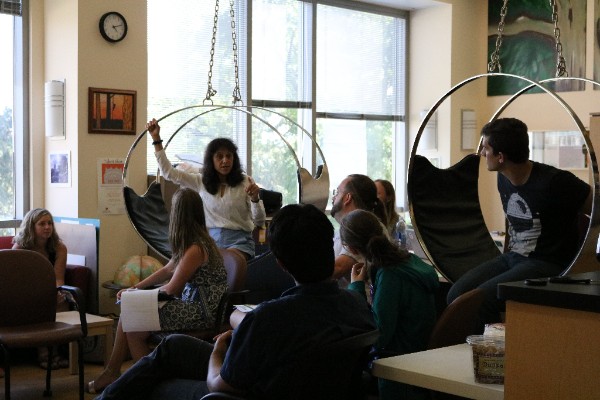
Since its start two years ago, STEMAP has made leaps and strides in connecting the public to science with engagement events reaching from cooking schools to correctional facilities.
Check out the Impact Report and see how STEMAP has grown!
STEMAP Video
STEM Ambassador Reflections
We are excited to feature several articles from STEM Ambassadors in this month’s newsletter. Read about their engagement experiences below!
David Belnap at Liberty Senior Center
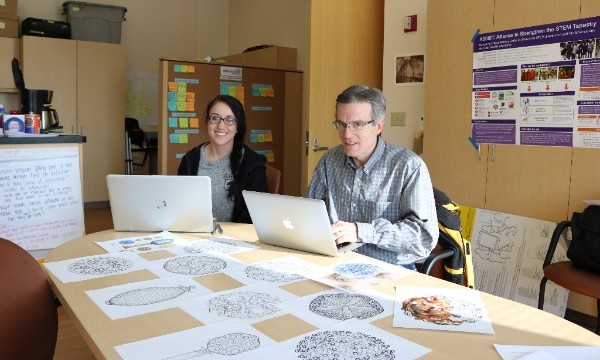
I visited the Girls Transition Center on November 17, 2017. This was my second visit. I visited one year earlier. Just like a year ago, this visit was awesome! The young ladies were very attentive and asked great questions all through my presentation.
I showed some pictures of viruses, and we talked about what viruses are and how they infect cells and infect all living things. At the end, Matt Whittaker and I gave them copies of the coloring book. I hope to go there again.
Lauren Williams at 10th East Senior Center

I gave an interactive presentation at Tenth East Senior Center to demonstrate how researchers are using basic science to help address problems in the real world. In my field, for example, many cognitive scientists are applying their knowledge of attention and perception to help better understand how radiologists find abnormalities in medical images.
For example, just as research participants in the lab often fail to notice a person in a gorilla suit walk through a game when counting the number of basketball passes between players (i.e., “The Invisible Gorilla”), radiologists may be less likely to detect one abnormality (e.g., cancer) when they are looking carefully for something else (e.g., broken bones). By understanding when our cognitive systems are likely to fail, we can better predict when errors will occur in radiology and how they might be prevented.
The participants at Tenth East were very eager to learn more about how cognitive science research can be applied to medicine. It was a pleasure to speak with such an engaged audience!
Dara Niketic’s Science Tattoo Night
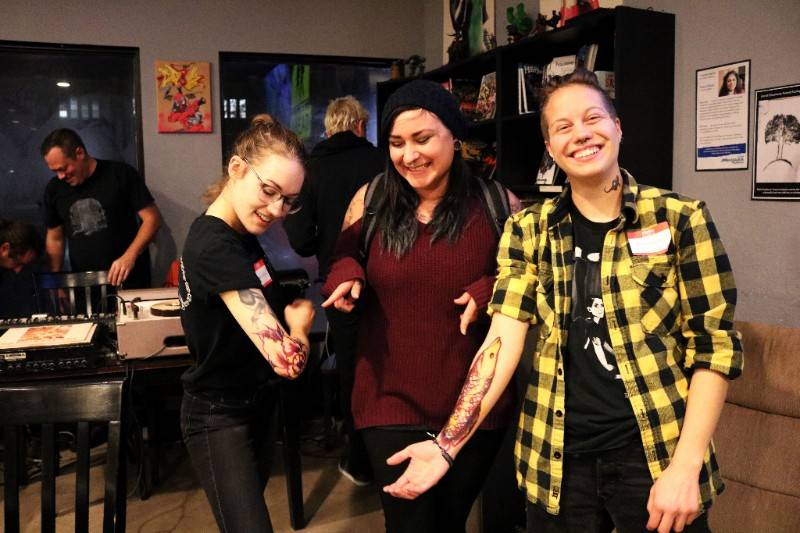
My STEM engagement event, which took place at Watchtower Café last November, aimed to unite members of the public with scientists from the University of Utah through a mutual interest in tattoos and art. The event focused on scientists sharing their science-related ink and included a scavenger hunt that encouraged participants to talk to scientists at the event about the science behind their tattoo designs.
Two tattoo artists, Laz Barath and Krystal Johnson, from Ironclad Electric Tattooing, joined the event to provide their unique perspective as artists. Laz brought a tattoo machine to allow participants to see how his equipment worked, and Krystal used markers to hand draw temporary tattoo designs. After the event, I sat down with Krystal to learn about her experience as a tattoo artist and her encounters with science in the tattoo world. Krystal has tattooed all over the United States, but now has a permanent position at Ironclad. Her tattooing style draws inspiration from Art Nouveau (think Alphonse Mucha). Her decision to become a tattooer stemmed from her longtime love of both art and tattoos, “It’s like it just clicked – this is how I can do art and make money for it.”
When asked how often she tattoos science-related designs, she said, “If you mean a plant or a flower, almost every single day… but people don’t think of it that way.” In her experience, some of the most commonly tattooed designs are botanical images. However, the connection between these designs and the science behind them is typically not made. In terms of tattoos that are very specific to STEM, Krystal says she has done some chemical structures, like dopamine and serotonin. Krystal pointed out that many artists, herself included, would likely be interested in working with scientists to design science-themed tattoos that incorporate the artist’s unique style. Such designs might even be displayed in shops to give clients new ideas for tattoos
Krystal provided me with valuable advice on how to effectively grow my public engagement work in the tattoo world. She feels people will be excited about the project if they can sense my passion for my research. This advice surely applies to any public engagement project – enthusiasm for one’s own work is a key component to making connections with a general audience. My meeting with Krystal will inform my future engagement work, which will be a continuation of the tattoo project. This will involve collaborating with Krystal to design science-themed tattoos. Scientists interested in getting involved with the project by sharing their science-themed ink, providing expertise for the science tattoo design, or anything else are invited to contact me at dara.niketic@utah.edu.
Benefits of Engagement Survey
Has your experience engaging with the non-scientific community shifted your perspective on your own research? Nalini Nadkarni (University of Utah) and Doug Levey (National Science Foundation) are documenting how public engagement benefits scientists. We encourage all STEM Ambassadors to participate in this short survey and share examples of how your public engagement work has altered your scientific research, career, and perspective.
Please submit your responses by February 28th!
About the Blog
Discussion channel for insightful chat about our events, news, and activities.
Categories
Featured Posts
Tag Cloud
- UoG (2)
- Guam (2)
- ethnobotany (1)
- environmental policy (1)
- student immersion (1)
- engineering (1)
- Virgin Islands (1)
- USVI (2)
- lionfish (1)
- children's home (1)
- conservation (1)
- marine ecology (1)
- youth (1)
- sustainability (2)
- Utah (1)
- Arizona (1)
- Nevada (1)
- southwest (1)
- virtual (1)
- project management (1)
- training (1)
- naturalist (1)
- forest (1)
- ecosystem (1)
- Puerto Rico (1)
- Spanish (1)
- library (1)
- Huntington's (1)
- medical science (1)
- Emmanuel Ngwoke (1)
